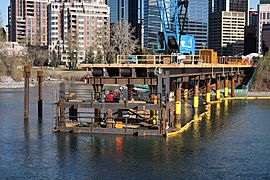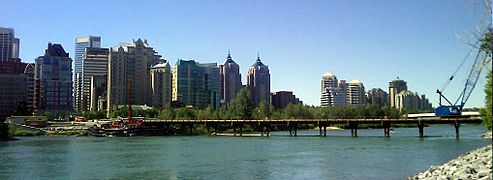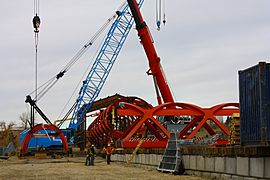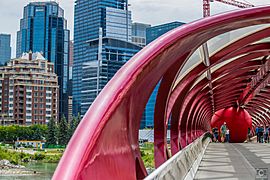Peace Bridge (Calgary) facts for kids
Quick facts for kids Peace Bridge |
|
|---|---|
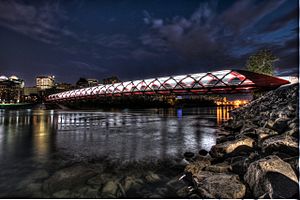 |
|
| Coordinates | 51°03′14″N 114°04′44″W / 51.05389°N 114.07883°W |
| Carries | Pedestrian pathway, bike path |
| Crosses | Bow River |
| Official name | Peace Bridge |
| Maintained by | City of Calgary |
| Characteristics | |
| Design | Double helix tubular truss |
| Material | Steel |
| Total length | Out to Out 130.6 meters (428 ft) |
| Width | 6.2 meters (20 ft) |
| Height | 5.85 meters (19.2 ft) |
| Number of spans | 1 |
| Piers in water | 0 |
| History | |
| Designer | Santiago Calatrava |
| Constructed by | Graham Group Ltd. |
| Construction begin | March 2010 |
| Construction end | March 2012 |
| Opened | 2012-03-24 |
Peace Bridge is a bridge that accommodates people walking and cycling across the Bow River in Calgary, Alberta, Canada. The bridge, designed by Spanish architect Santiago Calatrava, opened for use on March 24, 2012. It has the popular nickname "Finger Trap Bridge" for its visual similarity to the finger trap puzzle.
The bridge was built by The City of Calgary to connect the southern Bow River pathway and Downtown Calgary with the northern Bow River pathway and the community of Sunnyside. This connection was designed to accommodate the increasing number of people commuting to and from work and those utilizing Calgary's pathways. The bridge is reportedly used by 6000 people a day and has ranked among the top 10 architectural projects in 2012 and among the top 10 public spaces of 2012.
Design
The design follows strict requirements with no piers in the water (in an effort to minimize the ecological footprint) and restricted height (due to the vicinity of the City/Bow River Heliport).
The bridge has also been designed to:
- Withstand Calgary's one-in-100 year flood cycle
- Meet a minimum 75-year life span
- Allow barrier free access for people of all mobility types
- Provide comfort and security through lighting
The bridge is a departure from Calatrava's previous designs, which were typically asymmetric shapes anchored by high masts. Another atypical element is the color; while most of Calatrava's designs are white, the Peace Bridge features red and white as used in both the Flag of Canada and the Flag of Calgary.
- Features
- Helical steel structure with a glass roof (850-metric-tonne steel)
- A width of 6.3 metres - double the width of other pedestrian bridges in the area
- Segregated bicycle and pedestrian traffic
- Lighting for night time use
- Materials used
- Steel for the arches
- Reinforced concrete abutments & deck
- Dimensions
- Span length: Tube Girder 126 meters (413 ft)
- Total length: Out to Out 130.6 meters (428 ft)
- Total width: 8 meters (26 ft)
- Total height: 5.85 meters (19.2 ft)
- Inside width: 6.2 meters (20 ft) (3.7 meters (12 ft) for pedestrian and 2.5 meters (8.2 ft) for cycleway)
Cost
Funding for the Peace Bridge was provided by the city's capital budget. For the transportation department, targeted expenditures of capital are directed by the Transportation Infrastructure Investment Program (TIIP), which defines the priority and timing of major infrastructure construction projects. This program emphasizes pedestrian and cycling in high-density areas where these modes are more efficient at moving people, supporting land use and lessening environmental impacts. As of February 2012, the approximate costs were:
- Total: $22.495 Million
- Construction: $17.995 million
- Architectural and structural design, specialized engineering and quality assurance: $3.9 million
- Project administration and contingency: $2.6 million
History
On September 8, 2008, Calgary City Council approved report LPT2008-49 which set aside $25 million for the Pedestrian Gateways project for two bridges across the Bow River: one west of Prince's Island Park and one at the west of St. George's Island. The decision directed Administration to design and build one bridge and develop a concept design for a second one.
Construction started in March 2010. A temporary structure was built immediately upstream from the bridge location and served as a place to assemble the bridge before moving it to its final position.
The tubular bridge was manufactured in Spain and shipped to Calgary. Assembly of the bridge pieces started in Fall 2010 and the bridge was moved across the Bow River in November 2011.
During routine weld inspection, it was discovered that some of the welds did not comply with quality standards. As a result, the city hired an independent inspection company to do a more thorough inspection of the welds completed in Spain. The added inspections, red flags about the steel work's esthetics, weld repairs, and issues with damaged concrete slabs all contributed to multiple delays in the opening of the bridge.
The bridge, originally supposed to be opened in the fall of 2010, opened to the public on March 24, 2012.
To commemorate Canada Day 150, the Red Ball Project was installed for a day (June 26, 2017) on Calgary's Peace Bridge.
See also
 In Spanish: Puente de la paz (Calgary) para niños
In Spanish: Puente de la paz (Calgary) para niños


